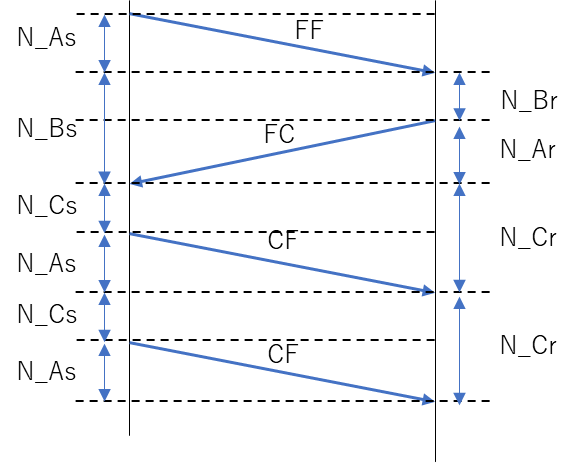Click here for back issues.
https://www.simulationroom999.com/blog/diagnostic-communication-en-back-issue/
Introduction.
Explanation of the network layer of vehicle diagnostic communication.
In this article, specific values for various timeouts will be explained.
Specific values for timeout parameters
In the last issue, I explained the various timeout parameters of ISO-TP, but did not give any specific values.
In this issue, I will explain them.
These values are defined in the standard, but there are two major patterns.
As those with good senses may have noticed, they are divided into UDS and OBD.
The basic idea is the same, but the specific values are very different.
I’ ll try to write them down one by one.
Specific values for ISO15765-2 (UDS) timeout parameters
First, ISO15765-2 (UDS side).
The specific values of timeout parameters are shown in the table below.
The previous diagram of the timeout parameters for multiframe transmission is also included.

| Parameter name | Timeout[ms] |
|---|---|
| N_As | 1000 |
| N_Ar | 1000 |
| N_Bs | 1000 |
| N_Br | (N_Br+N_Ar) < (N_Bs×0.9) |
| N_Cs | (N_Cs+N_As) < (N_Cr×0.9) |
| N_Cr | 1000 |
Most of the timeout values are quite relaxed, with a timeout value of 1 second.
And N_Br and N_Cs are oddly expressed.
N_Br and N_Cs are strictly performance requirements rather than timeout parameters.
In the case of N_Br,
“Complete FC transmission in about 90% of the time of N_Bs.”
This means.
90% of 1 second is 900[ms], so it is not such a strict requirement.
Specific values for ISO15765-4 (OBD) timeout parameters
This section explains the timeout values of ISO15765-4 (OBD).
The specific values of the timeout parameter are written in a table below.
This one is also accompanied by a diagram of the timeout parameters for the previous multiframe transmission.

| Parameter name | Timeout[ms] |
|---|---|
| N_As | 25 |
| N_Ar | 25 |
| N_Bs | 75 |
| N_Br | (N_Br+N_Ar) < 25 |
| N_Cs | (N_Cs+N_As) < 50 |
| N_Cr | 150 |
Compared to UDS, the timeout value is considerably shorter.
However, it is not that severe a value given the responsiveness of CAN.
But why is the timeout so short for OBD when it was about 1 second for UDS?
I don’t know the reason, but it may be motivated by some higher acquisition rate of vehicle parameters during emissions testing.
It would be impossible to evaluate if the data update of engine speed or vehicle speed is more than 1 second.
Another reason is that emission ECUs are powertrain ECUs and often use relatively high-specification microcontrollers, so they can manage even with strict response requirements.
The UDS targets ECUs running on low-spec microcontrollers, such as body ECUs, so the responsiveness requirements are extremely low.
There is another way of thinking about it.
It is better to think that there are more variations of specifications because there are many possible situations.
Conclusion.
- ISO15765-2 (UDS) and ISO15765-4 (OBD) have different values for the timeout parameter.
- The UDS side is looser and the OBD side is stricter.
- Some timeout parameters are set as performance requirements.
- N_Br and N_Cs.
Click here for back issues.
![[DoCAN] Vehicle Diagnostic Communication Part 12 [ISO-TP 8]](https://www.simulationroom999.com/blog/wp-content/uploads/2022/11/01_eyecatch-8.png)



コメント